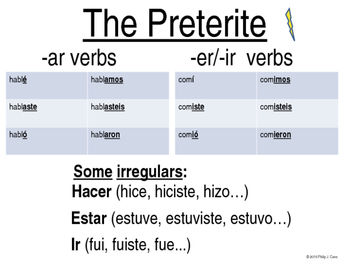

Let’s take a look at some imperfect tense in Spanish examples.Īs you’re reading them, try making up your own sentences to talk about your past. In general, we talk about four key uses of the imperfect. When to use the Spanish imperfect tense: 4 golden rulesĪs we covered earlier, the imperfect tense is used to describe actions in the past that don’t have a definite end date. So, when exactly do we use this past tense?īusuu’s award-winning app helps you stay on track with a Study Plan and smart tech that knows exactly what you need to revise. Wondering why ver is irregular if it has the same -er verb endings as a regular verb? Because it doesn’t drop the ‘e’ from the infinitive form. While they are irregular, there is still a method to the madness, as you can see, they still follow a pattern. Now we’ve covered the regular verbs, let’s take a look at those three irregular verbs. So let’s get on to the conjugations! Regular verbs We’ll tell you all about them a little later on. If you’re wondering about irregular verbs, the good news is there are only three. Remembering these two rules will significantly reduce the amount of endings you need to memorise. The endings for yo and él / ella / usted are also the same.The endings for regular verbs ending in -er and -ir are exactly the same.The endings for the imperfect tense follow two rules:
IMPERFECT SPANISH ENDINGS IR HOW TO
“I love learning conjugations”, said no one ever!īut we’ve got two handy rules to help you learn how to conjugate verbs in the Spanish imperfect. Via GIPHY How to form the imperfect tense in Spanish Starting to make sense? Just remember, it’ll become clearer the more you use it. In all of these sentences, we don’t know exactly when these actions happened, just that they’re some time in the past. Here, the imperfect is used to give us background to what Mercedes was doing when she was interrupted by the phone ringing. Just when I was leaving the house, the phone rang. Let’s take a look at another: Justo cuando salía de casa sonó el teléfono.

In this sentence, the imperfect is used to give background to the story – they were in garden – when it started to rain. We were in the garden when it started to rain. Think of it as the key to setting the scene when you start telling a story.įor example: Estábamos en el jardín cuando comenzó a llover. The other way to think about the Spanish imperfect is when you want to describe the circumstances – or the background – in which an event took place. Here, we don’t know the exact date when the speaker (let’s call them Mercedes) stopped living in Madrid with their parents – so we use the imperfect tense. When I was small, I lived in Madrid with my parents. Let’s take a look at another example: Cuando era pequeño vivía en Madrid con mis padres. We don’t know when the family stopped vacationing at the beach.Īll we know is that they don’t anymore (sad face), so we use the imperfect tense. My family and I vacationed at the beach every year. To help decide if you should be using the Spanish imperfect, ask yourself, does the action have a definite completion date? If not, then it’s likely you’ll need to use the imperfect tense.įor example: Mi familia y yo íbamos de vacaciones a la playa todos los años. The Spanish imperfect ( pretérito imperfecto del indicativo) is the tense we use to talk about past events that haven’t ended or recurrent past events. When used correctly, this tense is the perfect way to talk about the past! What is the imperfect tense?ĭon’t be tricked by the word imperfect. So let’s jump in and take a look at everything you need to know about the Spanish imperfect – what it is, how to form it and when to use it. We use the Spanish imperfect tense to describe past events or recurring actions that don’t have a specific end date.Įven though English doesn’t have a direct equivalent tense, once you understand the basic rules around when to use the imperfect tense in Spanish, it’ll become second nature. You might even find you begin to overuse it as it’s very easy to conjugate verbs in the imperfect!

So if you want to learn how to use the Spanish imperfect properly, keep reading to find out everything you need to know about this past tense.Īlthough there are quite a few past tenses in Spanish, the imperfect is one of the most commonly used – so it’s a good one to master.Īnd to be honest, it’s not as hard as you think. It’s easy to conjugate, but it can be tricky for English speakers to know exactly when to use it. The imperfect tense in Spanish is used to describe past actions or events that don’t have a specific end date.


 0 kommentar(er)
0 kommentar(er)
